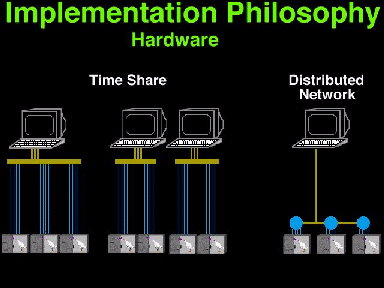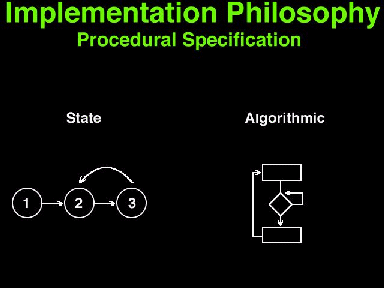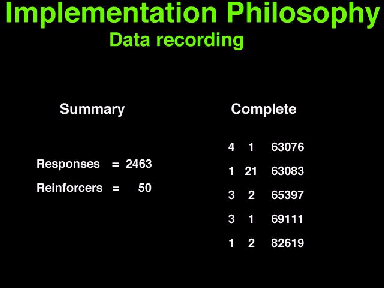 Slide 3-9
Slide 3-9

 Slide 3-9
Slide 3-9
Experiment control computers follow one of two hardware implementation philosophies.
One uses a relatively complex interface which allows a single computer to service multiple experiments (time share). This requires a relatively powerful computer, a relatively complex interface, relatively complex software, and long connecting cables. When capacity is exceeded, multiple computers must be used. As a result, no single administrative organization is available.
Our distributed network system allows the use of a relatively simple computer to supervise small special purpose computers mounted within each apparatus. This allows the interconnecting cables to be very simple and the administration of multiple experiments to be centralized. Up to 16 extremely complex experiments, each maintaining 1 millisecond accuracy, can be implemented.
 Slide 3-10
Slide 3-10
There are also two philosophies for implementing the specification of procedures.
One uses a state oriented language. Some procedures can be implemented in a simple way with this system. However, other procedure are very difficult to implement. Additionally, people not familiar with the language consider it arcane.
The alternative procedure specification approach uses an algorithmic language. We chose to develop an experiment control language with experiment control instructions and with the syntax of BASIC because it was easy to learn and easy to use. Most procedure are very simple to implement. An added advantage is that many people are available for help in programming in BASIC.
 Slide 3-11
Slide 3-11
There are also two ways of recording data, both are supported on our ECBASIC experiment controller.
One maintains simple totals of events of interest such as the total number of responses.
An alternative recording method relies on maintaining complete event logs. With this procedure a class of events (eg. 1 which is "stimulus on"), an event number (eg. 21 which is "red on right key"), and the time of occurrence of the event (eg. 63083 milliseconds into the session) is transparently logged to a disk file. None of these operations require manual handling by the ECBASIC program. Subsequent data analysis software is used to select which events are desired and to perform the desired calculations.
Date Last Reviewed : May 26, 2003